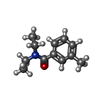[English] 日本語
 Yorodumi
Yorodumi- PDB-7lig: The structure of the insect olfactory receptor OR5 from Machilis ... -
+ Open data
Open data
- Basic information
Basic information
| Entry | Database: PDB / ID: 7lig | ||||||
|---|---|---|---|---|---|---|---|
| Title | The structure of the insect olfactory receptor OR5 from Machilis hrabei in complex with DEET | ||||||
 Components Components | MhOR5 | ||||||
 Keywords Keywords | MEMBRANE PROTEIN / olfactory receptor / ion channel / DEET | ||||||
| Function / homology | N,N-diethyl-3-methylbenzamide Function and homology information Function and homology information | ||||||
| Biological species |  Machilis hrabei (insect) Machilis hrabei (insect) | ||||||
| Method | ELECTRON MICROSCOPY / single particle reconstruction / cryo EM / Resolution: 2.9 Å | ||||||
 Authors Authors | del Marmol, J. / Ruta, V. | ||||||
| Funding support |  United States, 1items United States, 1items
| ||||||
 Citation Citation |  Journal: Nature / Year: 2021 Journal: Nature / Year: 2021Title: The structural basis of odorant recognition in insect olfactory receptors. Authors: Josefina Del Mármol / Mackenzie A Yedlin / Vanessa Ruta /  Abstract: Olfactory systems must detect and discriminate amongst an enormous variety of odorants. To contend with this challenge, diverse species have converged on a common strategy in which odorant identity ...Olfactory systems must detect and discriminate amongst an enormous variety of odorants. To contend with this challenge, diverse species have converged on a common strategy in which odorant identity is encoded through the combinatorial activation of large families of olfactory receptors, thus allowing a finite number of receptors to detect a vast chemical world. Here we offer structural and mechanistic insight into how an individual olfactory receptor can flexibly recognize diverse odorants. We show that the olfactory receptor MhOR5 from the jumping bristletail Machilis hrabei assembles as a homotetrameric odorant-gated ion channel with broad chemical tuning. Using cryo-electron microscopy, we elucidated the structure of MhOR5 in multiple gating states, alone and in complex with two of its agonists-the odorant eugenol and the insect repellent DEET. Both ligands are recognized through distributed hydrophobic interactions within the same geometrically simple binding pocket located in the transmembrane region of each subunit, suggesting a structural logic for the promiscuous chemical sensitivity of this receptor. Mutation of individual residues lining the binding pocket predictably altered the sensitivity of MhOR5 to eugenol and DEET and broadly reconfigured the receptor's tuning. Together, our data support a model in which diverse odorants share the same structural determinants for binding, shedding light on the molecular recognition mechanisms that ultimately endow the olfactory system with its immense discriminatory capacity. | ||||||
| History |
|
- Structure visualization
Structure visualization
| Movie |
 Movie viewer Movie viewer |
|---|---|
| Structure viewer | Molecule:  Molmil Molmil Jmol/JSmol Jmol/JSmol |
- Downloads & links
Downloads & links
- Download
Download
| PDBx/mmCIF format |  7lig.cif.gz 7lig.cif.gz | 276.7 KB | Display |  PDBx/mmCIF format PDBx/mmCIF format |
|---|---|---|---|---|
| PDB format |  pdb7lig.ent.gz pdb7lig.ent.gz | 219.4 KB | Display |  PDB format PDB format |
| PDBx/mmJSON format |  7lig.json.gz 7lig.json.gz | Tree view |  PDBx/mmJSON format PDBx/mmJSON format | |
| Others |  Other downloads Other downloads |
-Validation report
| Summary document |  7lig_validation.pdf.gz 7lig_validation.pdf.gz | 1 MB | Display |  wwPDB validaton report wwPDB validaton report |
|---|---|---|---|---|
| Full document |  7lig_full_validation.pdf.gz 7lig_full_validation.pdf.gz | 1.1 MB | Display | |
| Data in XML |  7lig_validation.xml.gz 7lig_validation.xml.gz | 48.1 KB | Display | |
| Data in CIF |  7lig_validation.cif.gz 7lig_validation.cif.gz | 68.7 KB | Display | |
| Arichive directory |  https://data.pdbj.org/pub/pdb/validation_reports/li/7lig https://data.pdbj.org/pub/pdb/validation_reports/li/7lig ftp://data.pdbj.org/pub/pdb/validation_reports/li/7lig ftp://data.pdbj.org/pub/pdb/validation_reports/li/7lig | HTTPS FTP |
-Related structure data
| Related structure data |  23375MC  7licC  7lidC M: map data used to model this data C: citing same article ( |
|---|---|
| Similar structure data |
- Links
Links
- Assembly
Assembly
| Deposited unit | 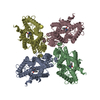
| ||||||||||||||||||||||||||||||||||||||||||||||||||||||||||||||||||
|---|---|---|---|---|---|---|---|---|---|---|---|---|---|---|---|---|---|---|---|---|---|---|---|---|---|---|---|---|---|---|---|---|---|---|---|---|---|---|---|---|---|---|---|---|---|---|---|---|---|---|---|---|---|---|---|---|---|---|---|---|---|---|---|---|---|---|---|
| 1 |
| ||||||||||||||||||||||||||||||||||||||||||||||||||||||||||||||||||
| Noncrystallographic symmetry (NCS) | NCS domain:
NCS domain segments:
NCS oper:
|
- Components
Components
| #1: Protein | Mass: 53736.695 Da / Num. of mol.: 4 Source method: isolated from a genetically manipulated source Source: (gene. exp.)  Machilis hrabei (insect) / Production host: Machilis hrabei (insect) / Production host:  Homo sapiens (human) Homo sapiens (human)#2: Chemical | ChemComp-DE3 / Has ligand of interest | Y | |
|---|
-Experimental details
-Experiment
| Experiment | Method: ELECTRON MICROSCOPY |
|---|---|
| EM experiment | Aggregation state: PARTICLE / 3D reconstruction method: single particle reconstruction |
- Sample preparation
Sample preparation
| Component | Name: Homotetrameric olfactory receptor MhOR5 in complex with DEET Type: COMPLEX / Entity ID: #1 / Source: RECOMBINANT |
|---|---|
| Source (natural) | Organism:  Machilis hrabei (insect) Machilis hrabei (insect) |
| Source (recombinant) | Organism:  Homo sapiens (human) Homo sapiens (human) |
| Buffer solution | pH: 7.4 |
| Buffer component | Conc.: 1 mM / Name: DEET |
| Specimen | Embedding applied: NO / Shadowing applied: NO / Staining applied: NO / Vitrification applied: YES |
| Vitrification | Cryogen name: ETHANE |
- Electron microscopy imaging
Electron microscopy imaging
| Experimental equipment |  Model: Titan Krios / Image courtesy: FEI Company |
|---|---|
| Microscopy | Model: FEI TITAN KRIOS |
| Electron gun | Electron source:  FIELD EMISSION GUN / Accelerating voltage: 300 kV / Illumination mode: FLOOD BEAM FIELD EMISSION GUN / Accelerating voltage: 300 kV / Illumination mode: FLOOD BEAM |
| Electron lens | Mode: BRIGHT FIELD |
| Image recording | Electron dose: 1.51 e/Å2 / Film or detector model: GATAN K2 SUMMIT (4k x 4k) |
- Processing
Processing
| Software |
| ||||||||||||||||||||||||
|---|---|---|---|---|---|---|---|---|---|---|---|---|---|---|---|---|---|---|---|---|---|---|---|---|---|
| CTF correction | Type: PHASE FLIPPING AND AMPLITUDE CORRECTION | ||||||||||||||||||||||||
| 3D reconstruction | Resolution: 2.9 Å / Resolution method: FSC 0.143 CUT-OFF / Num. of particles: 56191 / Symmetry type: POINT | ||||||||||||||||||||||||
| Refinement | Cross valid method: NONE Stereochemistry target values: GeoStd + Monomer Library + CDL v1.2 | ||||||||||||||||||||||||
| Displacement parameters | Biso mean: 59.08 Å2 | ||||||||||||||||||||||||
| Refine LS restraints |
| ||||||||||||||||||||||||
| Refine LS restraints NCS |
|
 Movie
Movie Controller
Controller




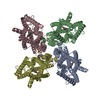
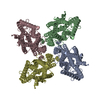
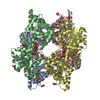
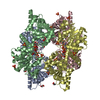


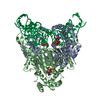
 PDBj
PDBj